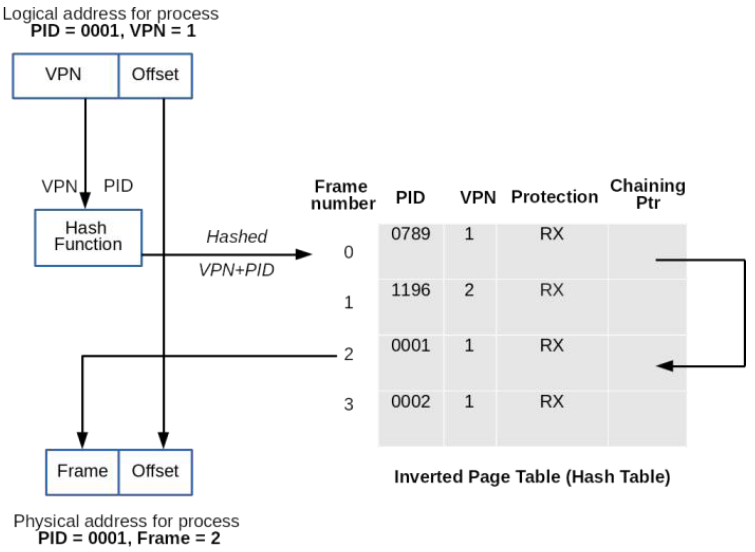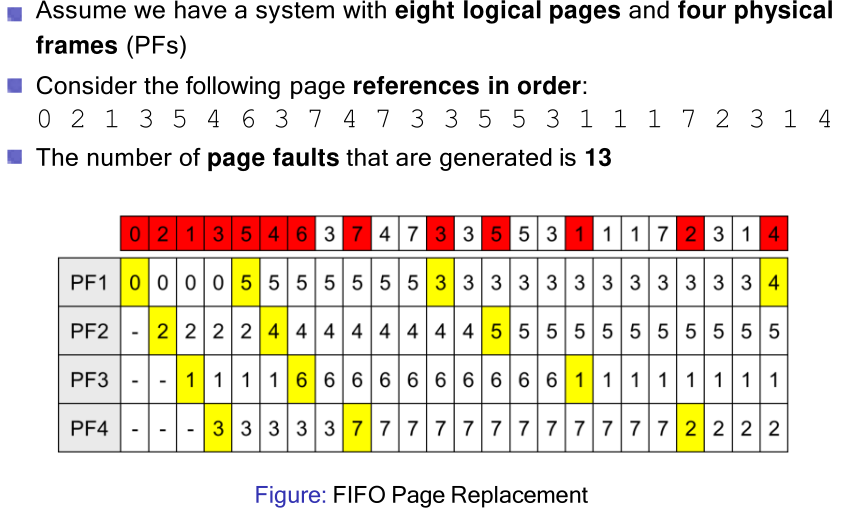16. Virtual Memory & Page Replacement
14/11/22
Virtual Memory
- Memory organisation of multi-level page tables
- The root page table is always maintained in memory
- Page tables themselves are maintained in virtual memory due to their size
- With two levels, every memory reference already becomes 3 times slower:
- Assuming that the second level page table is already in main memory
- Memory access already forms a bottleneck under normal circumstances
Translation look aside buffers (TLBs)
Basically a cache, most used page tables. Associative memory
- TLBs are usually located inside the MMU
- They cache the most frequently used page table entries
- They can be searched in parallel
- The principle behind them is similar to other types of caching in operating systems
- Remember: locality states that processes make a large number of references to a small number of pages
Inverted Page Tables
Normal - Is proportional to the number of pages in the virtual address space this can be prohibitive for modern machines
Inverted - Size is proportional to the size of main memory
The inverted table contains one entry for every frame (not page) and it indexes entries by frame number.
When a process references a page, the OS must search the (entire) inverted page table for the corresponding entry this could be too slow
Solution: Use a hash function that transforms page numbers into frame numbers
The frame number will be the index of the inverted page table
Process Identifier(PID) - The process that owns this page
Virtual Page Number (VPN) - We don't know if its in memory
Protection bits (Read/Write/Execution)
Chaining Pointer - The field points toward the next frame that has exa
 ctly the same VPN. Need to solve collisions
ctly the same VPN. Need to solve collisions

| Advantages | Disadvantages |
|---|---|
| OS maintains a single inverted page table for all processes | Virtual-to-physical translation becomes much harder/slower |
| Saves lots of space | Hash tables eliminates the need of searching the whole inverted table, need to handle collisions |
TLBs are particularly necessary to improve their performance Pages are shuttled between primary and secondary memory
Two key decisions have to be made using virtual memory
- Which pages are loaded and when predictions can be made
- What pages are removed from memory and when page replacement algorithms Pages are shuttled between primary and secondary memory
Implementation details
Avoid unnecessary pages and page replacement is important
= denote the memory access time = page fault rate = page fault time Effective access time is given by: Not considering here TLBs
Demand Paging
Starts the process with no pages in memory
- First instruction will immediately cause a page fault
- More page faults will follow, but they will stabilise over time until moving to the next locality
- The set of pages that is currently being used is called its working set/resident set Pages are only loaded when needed
Pre-Paging
When the process is started, all pages expected to be used could be brought into memory at once
- This can drastically reduce the page fault rate
- Retrieving multiple (contiguously stored) pages reduces transfer times Pre-paging loads pages before page faults are generated
Page Replacement
- OS must choose a page to remove when a new one is loaded
- This choice is made by page replacement algorithms and takes into account
- When the page is last used/expected to be used again
- Whether the page has been modified
- Replacement choices have to be made intelligently to save time/avoid thrashing
Optimal Page Replacement
Optimal world
- Each page is labelled with the number of instructions that will be executed/length of time before it is used again
- The page which is not going to be referenced for the longest time is the optimal one to remove Optimal approach is not possible to implement
- It can be used for post execution analysis
- It provides a lower bound on the number of page faults
FIFO
- Maintains a linked list and new pages are added at the end of the list
- The oldest page at the head of the list is evicted when a page fault occurs
- The (dis-)advantages are:
- Easy to understand/implement
- It performs poorly heavily used pages are just as likely to be evicted as a lightly used pages
